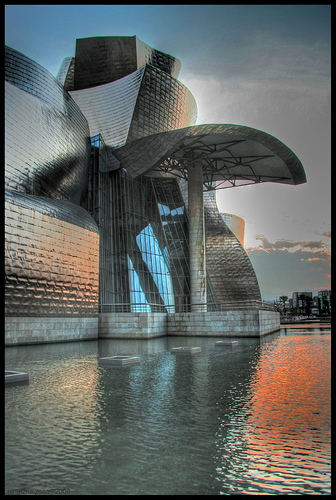October 9th, 2007 — 12:00am
JG Ballard is one of the most architecturally oriented writers I know. His writing evokes the physical and mental experiences of spaces and places deftly and vividly. No accident then that Ballard’s work is connected to psychogeography by many (an idea I’ve mentioned before as well). And so it is a pleasure to read his piece on Gehry’s Bilbao Guggenheim, The larval stage of a new kind of architecture, in Monday’s Guardian.

From the article:
More to the point, I wonder if the Bilbao Guggenheim is a work of architecture at all? Perhaps it belongs to the category of exhibition and fairground displays, of giant inflatables and bouncy castles. The Guggenheim may be the first permanent temporary structure. Its interior is a huge disappointment, and confirms the suspicion that the museum is a glorified sales aid for the Guggenheim brand. There is a giant atrium, always a sign that some corporation’s hand is sliding towards your wallet, but the galleries are conventionally proportioned, and one can’t help feeling that they are irrelevant anyway. The museum is its own work of art, and the only one really on display. One can’t imagine the Mona Lisa, the Venus de Milo or Picasso’s Guernica ever being shown here. There would be war in heaven. Apart from anything else, these works have a dimension of seriousness that the Guggenheim lacks. Koons’ Puppy, faithfully guarding the entrance to the enchanted castle, gives the game away. Architecture today is a visitor attraction, deliberately playing on our love of the brightest lights and the gaudiest neon. The Bilbao Guggenheim’s spiritual Acropolis is Las Vegas, with its infantilising pirate ships and Egyptian sphinxes. Gehry’s museum would be completely at home there, for a year at least, and then look a little dusty and jaded, soon to be torn down and replaced by another engaging marvel with which our imaginations can play.
Novelty architecture dominates throughout the world, pitched like the movies at the bored teenager inside all of us. Universities need to look like airports, with an up-and-away holiday ethos. Office buildings disguise themselves as hi-tech apartment houses, everything has the chunky look of a child’s building blocks, stirring dreams of the nursery.
But perhaps Gehry’s Guggenheim transcends all this. From the far side of the Styx I’ll look back on it with awe.
Comment » | Architecture
October 8th, 2007 — 12:00am
Comment » | Daily Links
October 4th, 2007 — 12:00am
Comment » | Daily Links
October 2nd, 2007 — 12:00am
My presentation slides from the Ethics Panel at EuroIA 2007 – titled Designing Ethically – Communicating Conflict: Design For the Integrated Experiences of the Future – are available from Slideshare at http://www.slideshare.net/moJoe. Ethics was a challenging and fascinating subject to take on, and it prompted some great discussion with the audience (even at 7pm, after a full day of sessions…)
Many thanks to fellow panelists Olly Wright and Thom Froehlich, and all who planned, organized, attended, spoke, volunteered, or otherwise contributed to EuroIA 2007. As you can see from the flickr photostream, it was worth the trip to Barcelona! I’m already looking forward to next year’s event in Amsterdam.
Here’s a quick description of the presentation:
“What does the future of design hold? Greater ethical challenges. In the coming world of integrated experiences, design will face increasing ethical dilemmas born of the conflicts between broader, diverse groups of users in social media; new hybrids such as the SPIME which bridges the physical and virtual environments simultaneously, and the DIY shift that changes the role of designers from creators of elegant point solutions, to the authors of elegant systems and frameworks used by others for their own expressive and functional purposes. To better prepare designers for the increased complexity, connectedness, and awareness included in the coming future, here are some practical suggestions for easily addressing conflict during the design of integrated experiences, by using known and familiar experience design methods and techniques.”
1 comment » | Ethics & Design, Everyware, Information Architecture, User Experience (UX)
October 2nd, 2007 — 12:00am
Comment » | Daily Links
September 28th, 2007 — 12:00am
Boxes and Arrows has published part 3 of the Building Blocks series, describing the Container blocks in detail. Next in the series is part 4, which describes the Connectors in the building block system in detail.

If you’re working on a portal, dashboard, or tile based design effort of any kind, the building blocks readily serve as a common language and structural reference point that allows effective project communication across traditional discipline boundaries. These two articles in tandem (parts 3 and 4) provide details on how the Building Blocks can provide a strong, flexible, and scalable usr experience and information architecture framework for the long term.
My current plan is to release a toolkit at approximately the same time as part 4 of the series. Part 4 is in the editing stage now, so this a good time to ask readers for suggestions on what should be part of the toolkit, and what form it should take. Suggestions?
Comment » | Building Blocks, Information Architecture, User Experience (UX)

